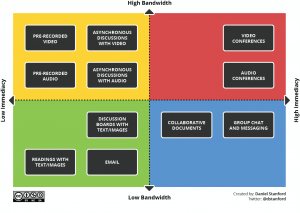1 Low bandwidth teaching and learning
Shifting to remote teaching and learning brings with it a number of considerations and challenges. If learners are able to connect to free/institutional networks (e.g., from local libraries, or on-campus student work areas), they will likely be able to access a safe, reliable, and robust internet connection. However, if these learners are relying on home-based connections, these will likely have a slower speed connection, and their service may be shared with others in their house (for work, or education, or entertainment).
Daniel Stanford’s recent article provides some guidance on the impact of videoconferencing on bandwidth and immediacy. His Bandwidth Immediacy Matrix (embedded below) prompts educators to shift our thinking, “[b]y reflecting on the unique pros and cons of each zone and the drawbacks that come with high-bandwidth/high-immediacy tools, we can identify ways to make our courses more flexible and accessible.”

Here’s a quick definition of internet bandwidth.
While we’re considering activities that lower the bandwidth, it’s also to have a refresher on how to optimize images, PDFs, etc. for effective distribution before you post them to your LMS or send them via email. And, if any students are reading this, these things are worth considering when you are putting together assignments. We’ve broken these down into separate pages, linked below. This is a work in progress, so if you have other suggestions for similar approaches, let us know and we’ll add to this list. These solutions are also mostly based on our experience working on Mac platforms, and there are likely some Windows-based tools that should be included here.


Feedback/Errata